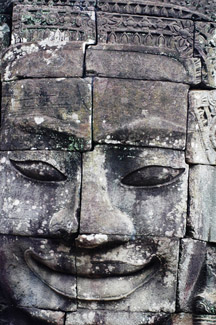
THE FLOWER SERMON:
Toward the end of his life, the Buddha took his disciples to a quiet pond for instruction. As they had done so many times before, the Buddha's followers sat in a small circle around him, and waited for the teaching.
But this time the Buddha had no words. He reached into the muck and pulled up a lotus flower. And he held it silently before them, its roots dripping mud and water.
The disciples were greatly confused. Buddha quietly displayed the lotus to each of them. In turn, the disciples did their best to expound upon the meaning of the flower: what it symbolized, and how it fit into the body of Buddha's teaching.
When at last the Buddha came to his follower Mahakasyapa, the disciple suddenly understood. He smiled and began to laugh. Buddha handed the lotus to Mahakasyapa and began to speak.
"What can be said I have said to you," smiled the Buddha, "and what cannot be said, I have given to Mahakashyapa."
Mahakashyapa became Buddha's successor from that day forward.
With the smile, Chan had its beginnings. When reading the Sutras, one often reads that the Buddha smiled prior to answering questions posed to him. The importance of the Buddha's smile can be seen by the many statue depictions of it. The historical Buddha is often affixed with a calm, confident, soft smile. What is the importance of this smile and how can it help our practice? I think the Buddha's smile is an often overlooked silent teaching that will move all towards awakening.
Let's look at Zazen, a major focus of Chan. Many consider that one's practice with zazen shows the overall strength of one's practice. Focus is made on things as they are, desiring nothing more than what is. But does this focus and desire form a basis for attachment? It can. The very act of a practice that is in place to end attachments can simultaneously open us up to the very pitfalls of attachment. This is why remembering and acknowledging the Buddha's smile is so important: the smile not only shows understanding, but compassion. We often think of compassion for all beings, but forget ourselves in that mix.
Our practice shows we are striving for something. This desire and striving can lead us straight to suffering and attachment, confronting the reality of the Four Noble Truths. If we are "here" and we want to get "there" in our practice, then a goal is set. If we get "there" the goal is reached, our ego is stroked. Conversely, if we remain "here", feelings of failure and disappointment will ensue. From this perspective we are caught in a loop that leads us back to square one, as both are ego driven. The Buddha smile gives a nod to the Self, penetrating the ego's mask.
Reality is that our practice is where it is and it is exactly where it should be when we are being consistent in our efforts. Smile - the act of practice is the "here" and "there." Watchful to ignore the ego as it whispers in our ear telling us that the that the desire for what is should be replaced by the desire for what should be. We embrace the process of practice, simply smiling at the inclination to be moving forward. When we don't want to sit for zazen, we smile and watch our urge not to, recognizing that Zen and zaZen are without difference.
The problem of ego comes in through the intellect in the form of definitions, comparisons, and judgments. What better way to combat these poisons of practice than with the simple Buddha smile? The compassionate smile stops our drive to intellectualize, usually out of fear, by compassionately breaking the status quo of our minds and allowing us to become aware of how our thoughts are working. It then allows us to move forward.
Freedom is found in seeing with the Buddha smile.
My first Zen teacher, David Spencer, introduced me to the Buddha smile by telling me to smile like the Buddha when things become complicated or difficult. I quickly found that doing the physical smile affected me emotionally. It brought a sense of relief to many trying situations. I think it comforts because it opens me up to what is and I resign the ego to the current moment. I accept the present situation as my ultimate teacher. I can instantly feel compassion when the smile is made when in emotional trauma: compassion for me, as well as all beings in the situation with me. It is a kind of Dharma "time out" of sorts.
In my home zendo I have a carved stone relief of the Buddha's face with that quiet smile. When I get into position for zazen, I often look up at the relief. Whenever I think my practice is not what it should be, the Buddha just smiles as if telling me to push on. When I think I'm doing really well in my practice, the Buddha still only smiles, perhaps telling me I have a longer way to go than I think. Perhaps not. When the last place I want to be is sitting on the cushion, the Buddha still smiles.
We must all carry the Buddha's metaphorical smile within us, that part of Buddhism that has no words. But from time to time we may also need to remember to physically give the gift of that same smile to ourselves.
May we all take refuge in the Buddha's smile.
